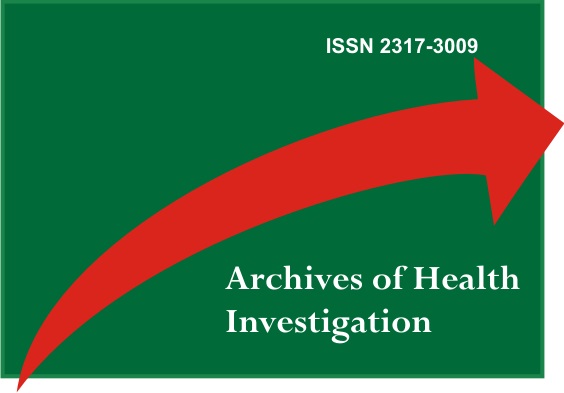Abscesso Odontogénico de Grandes Proporciones em Región Submandibular Izquierda: Reporte de Caso
DOI:
https://doi.org/10.21270/archi.v11i5.5973Palabras clave:
Infecciones Bacteriana, Cirurgia Bucal, DrenajeResumen
Las infecciones odontogénicas son recurrentes en el ambiente odontológico, sin embargo, no deben ser subestimadas ya que tienen un alto potencial para llevar la salud del paciente a condiciones clínicas graves. Además, las pruebas clínicas y de imagen son fundamentales para identificar los cambios fisiológicos asociados a las infecciones odontogénicas y, por tanto, el diagnóstico precoz para seleccionar mejor el abordaje clínico y el manejo quirúrgico. En este reporte de caso, el paciente presentaba una infección odontogénica derivada de numerosas raíces residuales en la región submandibular izquierda y en el tercio medio de la cara. Tras evaluación clínica y radiográfica se optó por tratamiento quirúrgico con extracción de focos infecciosos y drenaje intraoral de exudado purulento bajo abundante irrigación y solución salina al 0,9%. Se realizó procedimiento de extracción y drenaje del exudado bajo anestesia local y previa administración endovenosa de ampicilina con sulbactam y metronidazol. Posterior al procedimiento, se instruyó a la paciente para estimular compresas calientes y fisioterapia para facilitar el drenaje de la colección purulenta en su domicilio. Los medicamentos se mantuvieron por vía oral y el paciente fue devuelto al hospital para reevaluación y 48 horas. A los dos días del procedimiento y con drenaje exiguo, hubo disminución del drenaje, se retiró el drenaje y la paciente recibió indicaciones de tratamiento odontológico para los demás elementos dentarios y la necesidad de rehabilitación bucal. Por lo tanto, para evitar el avance de la infección odontogénica a tejidos más profundos de cara y cuello, así como para preservar la vía aérea, puede ser necesario un abordaje inmediato para asegurar un buen pronóstico.
Descargas
Citas
Bayetto K, Cheng A, Goss A. Dental abscess: A potential cause of death and morbidity. Aust J Gen Pract. 2020;49(9):563-567.
Shweta, Prakash SK. Dental abscess: A microbiological review. Dent Res J (Isfahan). 2013;10(5):585-91.
Zhou EH, Liu SR, Zhu HM, Yi HL, Chen XP. Management and postoperative use of double-cannula irrigation-drainage tube in cervical necrotizing fasciitis: a Chinese single-institution experience of 46 patients. Eur Arch Otorhinolaryngol. 2021;278(8):2975-2981
Seppänen L, Rautemaa R, Lindqvist C, Lauhio A. Changing clinical features of odontogenic maxillofacial infections. Clin Oral Investig. 2010;14(4):459-65.
Choi MG. Modified drainage of submasseteric space abscess. J Korean Assoc Oral Maxillofac Surg. 2017;43(3):197-203.
Brennan MT, Runyon MS, Batts JJ, Fox PC, Kent ML, Cox TL, Norton HJ, Lockhart PB. Odontogenic signs and symptoms as predictors of odontogenic infection: a clinical trial. J Am Dent Assoc. 2006;137(1):62-6.
Alotaibi N, Cloutier L, Khaldoun E, Bois E, Chirat M, Salvan D. Criteria for admission of odontogenic infections at high risk of deep neck space infection. Eur Ann Otorhinolaryngol Head Neck Dis. 2015;132(5):261-64.
Blankson PK, Parkins G, Boamah MO, Abdulai AE, Ahmed AM, Bondorin S, Nuamah I. Severe odontogenic infections: a 5-year review of a major referral hospital in Ghana. Pan Afr Med J. 2019;32:71.
Grönholm L, Lemberg KK, Tjäderhane L, Lauhio A, Lindqvist C, Rautemaa-Richardson R. The role of unfinished root canal treatment in odontogenic maxillofacial infections requiring hospital care. Clin Oral Investig. 2013;17(1):113-21.
Marioni G, Rinaldi R, Staffieri C, Marchese-Ragona R, Saia G, Stramare R, et al. Deep neck infection with dental origin: analysis of 85 consecutive cases (2000-2006). Acta Otolaryngol. 2008;128(2):201-6.
Ellison SJ. An outcome audit of three day antimicrobial prescribing for the acute dentoalveolar abscess. Br Dent J. 2011;211(12):591-94.
Kinzer S, Pfeiffer J, Becker S, Ridder GJ. Severe deep neck space infections and mediastinitis of odontogenic origin: clinical relevance and implications for diagnosis and treatment. Acta Otolaryngol. 2009;129(1):62-70.
Bertossi D, Barone A, Iurlaro A, Marconcini S, De Santis D, Finotti M, et al. Odontogenic Orofacial Infections. J Craniofac Surg. 2017; 28(1):197-202.
Juncar M, Bran S, Juncar RI, Baciut MF, Baciut G, Onisor-Gligor F. Odontogenic cervical necrotizing fasciitis, etiological aspects. Niger J Clin Pract. 2016;19(3):391-96.
Moghimi M, Baart JA, Karagozoglu KH, Forouzanfar T. Spread of odontogenic infections: a retrospective analysis and review of the literature. Quintessence Int. 2013;44(4):351-61.
Sh anti RM, Aziz SR. Should we wait for development of an abscess before we perform incision and drainage? Oral Maxillofac Surg Clin North Am. 2011;23(4):513-18.
Joo BY, Jang AL, Lee JH, Park HS, Kang MK, Hong JC. Application of ultrasound-guided pigtail catheter drainage for abscesses in the head and neck. Clin Otolaryngol. 2017;42(5):1087-91.
Doll C, Carl F, Neumann K, Voss JO, Hartwig S, Waluga R, et al. Odontogenic Abscess-Related Emergency Hospital Admissions: A Retrospective Data Analysis of 120 Children and Young People Requiring Surgical Drainage. Biomed Res Int. 2018; 2018:3504727.
Jones KC, Silver J, Millar WS, Mandel L. Chronic submasseteric abscess: anatomic, radiologic, and pathologic features. AJNR Am J Neuroradiol. 2003;24(6):1159-63.
Adhikari S, Blaivas M, Lander L. Comparison of bedside ultrasound and panorex radiography in the diagnosis of a dental abscess in the ED. Am J Emerg Med. 2011;29(7):790-95.


